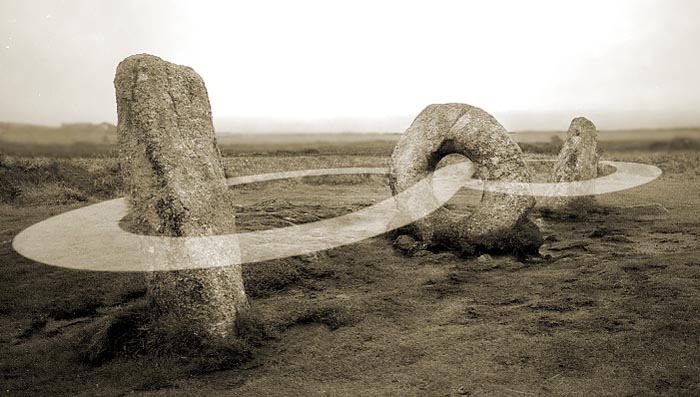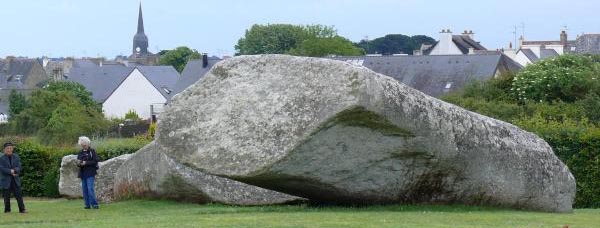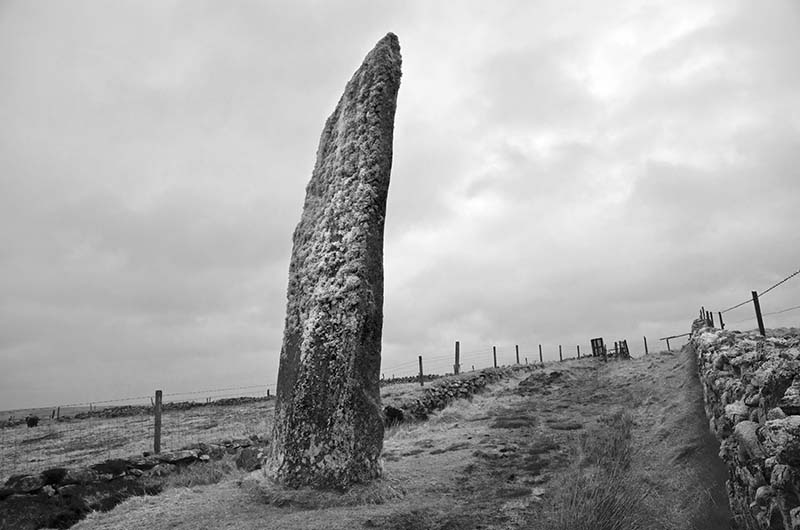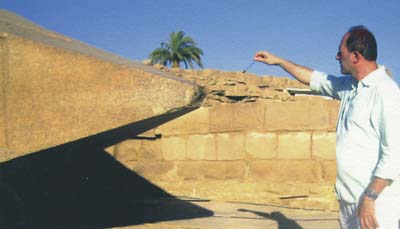
The correct choice of stone makes all the difference to the way a sacred site works.
Men An Tol is an odd-looking site in a bleak field of a sparse area of Cornwall. Three standing stones are aligned in a row, one tall and thin, the other small and squat; in-between lies a large, round stone with a hole carved in the centre, from which the site gets its gaelic name. Two other, smaller stones sit to the side a short distance away.
Only a small portion of this ancient healing place remains today, many of its original stones having been re-used in nearby stone walls that now divide the fields. Some of the stone posts that make-up local farm gates look suspiciously as thought they were originally fashioned for some other purpose.
The site may be a shadow of its former self yet it still remains a place potent in telluric currents. A simplified dowsing map of local magnetic forces shows how each of the stones was carefully aligned to alternating positive- and negative-charged lines of energy. The holed stone is itself aligned precisely at a node of both polarities — in other words, it is a node of balanced energy. And it is through this hole that countless pilgrims once threaded their dis-eased bodies, hoping these balanced energies would influence the body's electro-magnetic field, and in so doing, heal them of their affliction.
Today, people still come here to take advantage of these energies, because the energy is still present as though anchored by the ancient stones. Just as in the Victorian era, parents still send children through the holed stone, like an ancient— and inexpensive— alternative to a CAT Scan.
A strange case of modern science copying ancient healing arts? Probably.
A close look at the energy generated by the three standing stones shows how it moves between them like an infinity loop. In esoteric language this is the alpha and the omega that Jesus discussed as being the energy that binds the universe and the human body. the flow of the Universe. It is the positive and negative, the dark and the light in perfect balance, flowing in perpetual motion. Taoists have used initiation and meditation methods to achieve this flow so as to create teh conditions for out-of-body ecstatic states of awareness.
The relationship between needles of stone and magnetic fields is a long-standing tradition. Pardon the pun. These menhirs are some of the oldest sacred sites on Earth, they've been performing a kind of telluric acupuncture as far back as traditions can recall. They average six to eight feet tall; in Brittany, and especially around the Carnac area, some stand over 30 ft — such as themenhir at Dol — and several are only accessible at low tide, demonstrating how they were put there well before the last major sea level rise c.3000 BC, perhaps even as far back as 9600 BC.
The grand menhir at Locmariaquer once stood 60 ft tall and weighed over 350 tons. On a clear day ships in the Atlantic could see it for 15 miles and routinely used it as a guide into port. After an earthquake in the 17th century the monolith fell and split into five enormous pieces. Even on the ground it is an impressive site, considering the logistics involved in moving a piece of stone that even today few commercial cranes can handle.

Great menhir of Locqmariaquer, Brittany.
It is also worthwhile noting that the older the standing stone the bigger it gets. Stones found in the foundation of the temple of Baalbek weigh 1200 tons and are known to have been placed there some 11,000 years ago. It seems that as humanity evolved the loads got smaller which, from a historical point-of-view, means our knowledge has devolved. Teh conventional view holds that humanity is supposed to have first built small huts and progressed to erect skyscrapers. These megaliths contradict such a view, and reveal that the sacred sites we have inherited have come from more advanced civilization.
Several years ago, while investigating some forgotten menhirs in the Precesi Hills of Wales, I stumbled upon a 14-ft needle that looked forlorn. Its remote location on the map suggested no one had touched it in centuries; even the footpath that led there was no longer visible or discernable.
I sensed that the stone had much to tell— as if it had been waiting for someone to share lots of stories— and drawn by some magnetic attraction I walked up to it and stretched out my hand. Suddenly, an invisible force glued my hand to the face of the granite monolith and within seconds I was watching thousands of years of activity that had taken place around the stone: births, deaths, executions, marriages, healings. The experience was very real; a friend of mine who witnessed it took care of me while I was deabilitated for the following 48 hours, having been drained of energy. It felt as if I'd put my head inside a microwave oven.
This is a prime example of energy bottled up in the stones that is grounded by a person touching them. The British Society of Dowsers has numerous accounts of dowsers approaching standing stones only to be thrown back several feet in the air, as if hit by lightning; one ex-army corporal even lost the feeling in his forearm for 20 minutes.

The charge carried by standing stones is retained for some time. In Egypt, standing stones are called obelisks, and originally many of them performed the same kind of earth acupunture. While in Karnak I took the opportunity to test a fallen obelisk and see if there was any energy still held within the colossal block of red granite.
Using a pendulum to test the theory— and I had no idea what would happen, by the way— it took a mere three seconds for the device to swing and rotate wildly, to the point where it became airborne and horizontal. Clearly the stone was still capable of discharging despite years of being recumbent.
The obelisks have a history all of their own. After the Romans invaded Egypt several of the enigmatic stones were taken to Rome. They were also plundered by French and English grave robbers or narrow-minded archeologists, and taken to Paris, London, even New York. If one plots the obelisks' final resting places, from Cairo to Rome and the aforementioned cities, they form a near-perfect arc. So perhaps there was a plan behind the thieving after all.
The site that later would become the Vatican was originally a mound with a standing stone. This would later be replaced by a plaza whose centre is now marked by an Egyptian obelisk.
The name Vatican comes from the latin verb vaticinare, meaning to prophesy: a curious choice of name given that standing stones mark the nodes of energy which, in essence, are mediating points between forces of the visible and invisible worlds.
Return to Stone.
© Freddy Silva. No unauthorized reproduction.

Energy stored in the stone obelisk at Karnak still swirls a metal pendulum.